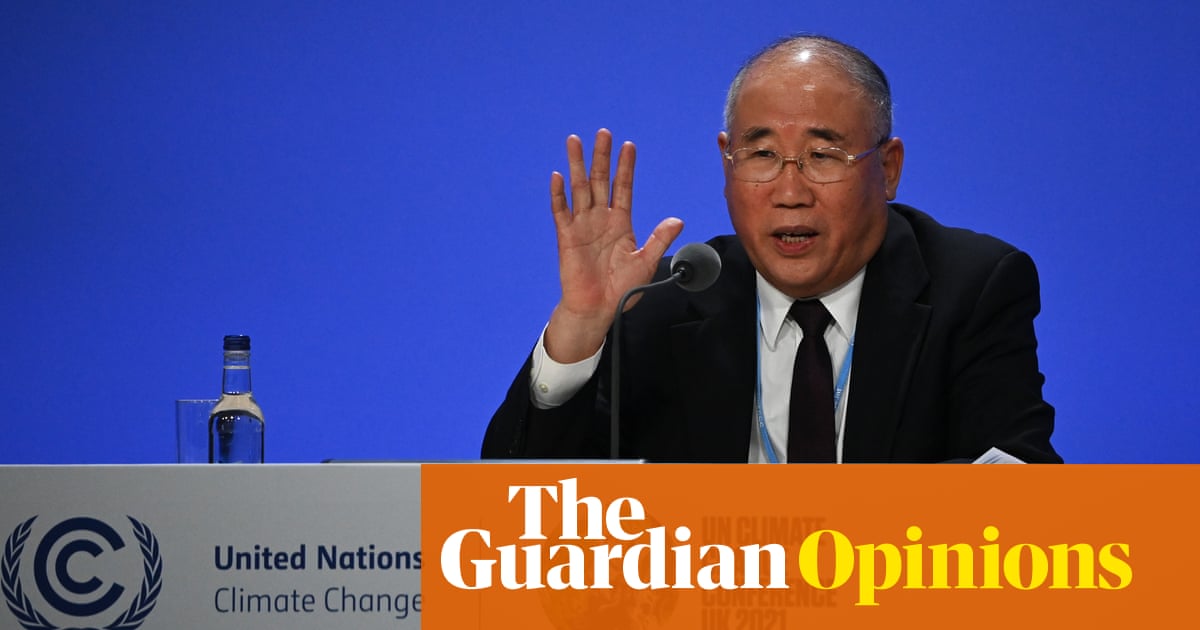
It could have been so much worse. At this critical juncture, talks between the world’s two carbon superpowers – together accounting for some 40% of global greenhouse-gas emissions – could easily have collapsed into a blame game, and a standoff that would have seriously set back global efforts. Instead, the surprise China-US agreement announced on Wednesday night offers renewed hope for joint leadership at last. After the bruising years of the Donald Trump presidency, and the impact of Covid-19 on the negotiations themselves and those poor countries most vulnerable to the climate crisis, trust in multilateralism hangs in the balance.
The new agreement is far from perfect and doesn’t go far enough. Despite promises to cooperate on reducing methane emissions, details in the plan are patchy and need more substance. It could even risk distracting from the multilateral work needed in these crucial last moments of the UN-led Cop26 talks. But it is still important, even inspiring, to see new cooperation emerge. The US and China climate envoys, John Kerry and Xie Zhenhua, shared warm words, the latter announcing that “there is more agreement between China and the United States than divergence.”
The two men have a long working relationship, and between them deserve credit for the signing of the Paris agreement, and the 2014 joint US-China announcement that helped set the diplomatic groundwork for it. Their cordiality certainly stands in contrast to the words of the US president, Joe Biden. Only a week earlier at a press conference in Glasgow, Biden referred to the Chinese president, Xi Jinping, and Russian president, Vladimir Putin, when he said, “They didn’t show up … It is a gigantic issue and they just walked away. How do you do that and claim to have any leadership mantle?”
So, what’s changed? Arguably, not much. The narrative that China was “missing in action” at Cop26 was always a red herring, based on a misreading of Xi’s absence – a decision clearly motivated by concerns about coronavirus transmission (arguably well-founded ones) and likely by domestic political events – rather than any snub. Diplomatic work, evidently, was continuing behind the scenes, building on the visits Kerry made to the Chinese cities of Shanghai and Tianjin earlier in the year. Now neither side needs to go home empty-handed, and can avoid the stinging accusation that they either spoiled the talks, or failed to get their biggest rival to the negotiating table.
The establishment of a joint “working group on enhancing climate action in the 2020s” is also more interesting than it sounds at first blush. In 2014, a bilateral climate announcement from Barack Obama and Xi Jinping was not only an important symbolic gesture that the world’s two largest carbon polluters were willing to work together towards a new treaty, it also kicked off a substantive programme of joint technical work on clean energy cooperation and more.
This looks to have been revived here, in a statement that points to the two nations’ intentions to cooperate on critical industrial challenges, such as green design, resource reuse and direct air capture of carbon dioxide. As Kerry put it in his remarks in Glasgow, these are globally pressing issues of “math and physics”, rather than politics.
But, of course, it is politics – and that’s why it matters, if only as a floor for ambition, not the ceiling. The announcement sets the right mood music ahead of Xi and Biden’s virtual meeting next week, but US-China relations will not return soon to the accord that Obama and Xi achieved. In most other arenas, from trade to cyber to Taiwan, the country’s leaders will likely find their interests and values remain at odds. New areas of conflict reflect a deep, tectonic shift in the geography of global power – not issues that can likely be resolved in the short or medium term.
Yet the climate emergency requires a far greater urgency – eight years to halve global emissions, according to the UN — and acting to address it requires ambition and coordination. The announcement puts paid to claims that China only engages in climate cooperation to extract concessions in other areas, such as human rights. Rather than being “suckered” into going easy on China, the US seems to have stayed the course on its foreign policy towards China in other areas, while recognising that the two countries have a common interest in working to address the climate emergency.
Tellingly, in his Cop26 press conference, Kerry invoked the critical 1986 meeting between Ronald Reagan and Mikhail Gorbachev in Reykjavik that began the process of nuclear disarmament. To extend the analogy, the US and China may need to recognise that in the present geopolitical conjuncture – the cold war might be an imperfect analogy, but it’s not so far off – strategic rivalry will be a constant. But their common interests in climate security require continued trust-building, coordination and technical exchange, much as the late 1980s saw continued work on arms control even at points of high tension.
In the near future, competitive and cooperative dynamics on climate will have to coexist. In fact, a race to the top, where healthy competition around the deployment of clean technology plays out in developing world markets that urgently need new investment in infrastructure, should be welcomed by all. The hope in this new agreement is that it is possible to create spaces for contention and rivalry, without taking the planet hostage.


